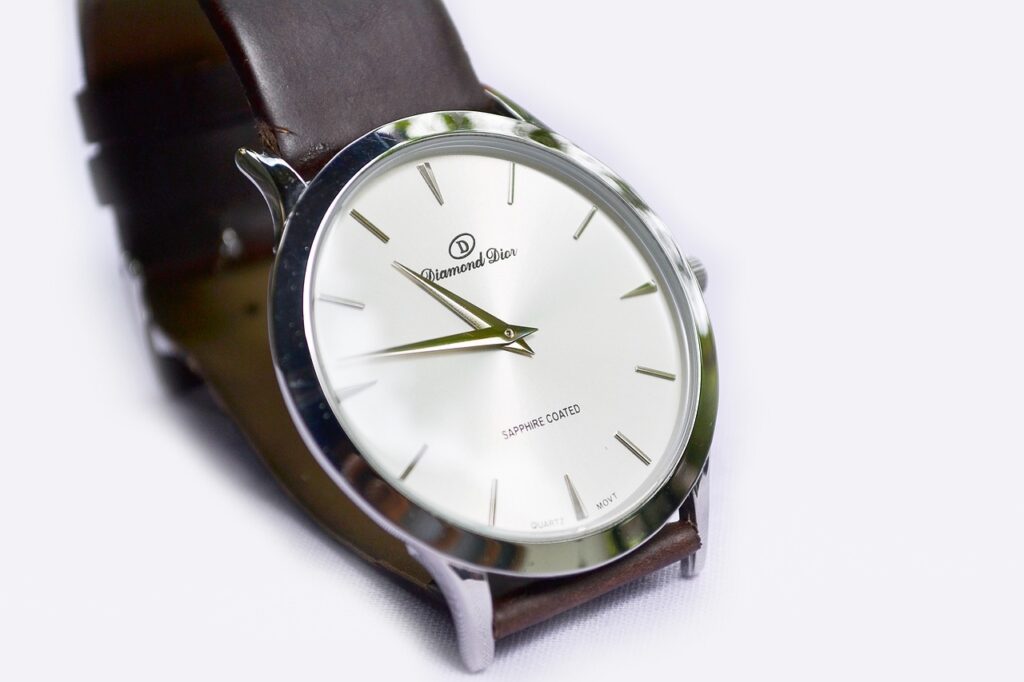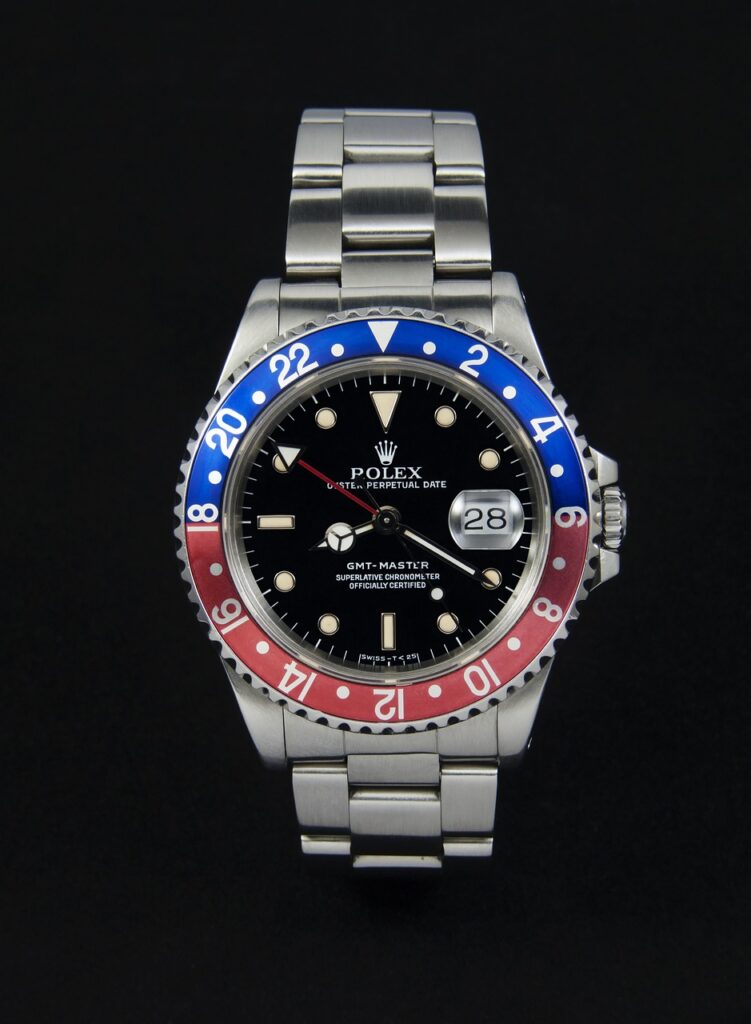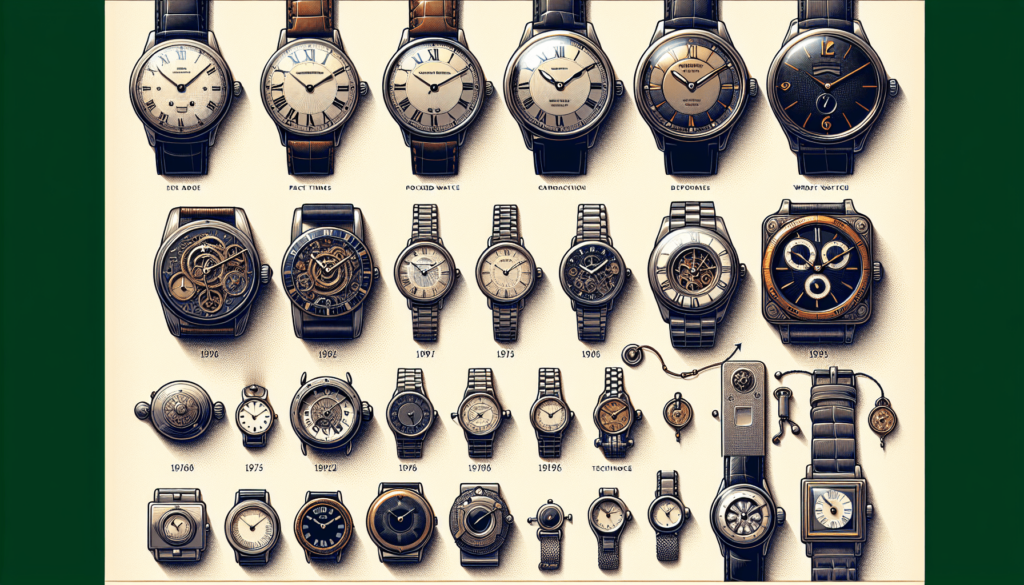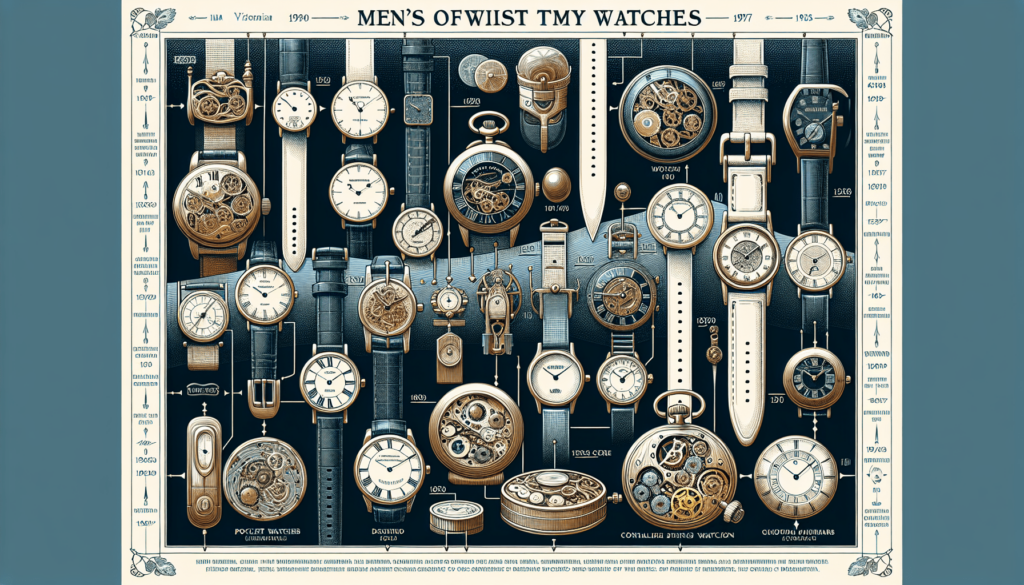In this fascinating article, you will discover the incredible journey of men’s wrist watches throughout history. From their humble beginnings as pocket watches, worn by the elite few, to their transformation into stylish and practical accessories for everyday use, the evolution of men’s wrist watches has been a captivating tale of innovation and craftsmanship. Join us as we explore the iconic timepieces that have not only kept track of the hours but also reflected the changing trends and societal shifts of their time. Get ready to be amazed by the intricate designs and timeless elegance that have made men’s wrist watches a true symbol of class and sophistication.
Early History of Timekeeping
Throughout history, humans have had a deep fascination with tracking and measuring time. The earliest known method of timekeeping was through the use of sundials. These simple devices featured a flat surface with a raised stick, or gnomon, that cast a shadow depending on the position of the sun. By observing the length and direction of the shadow, people could estimate the time of day.
As civilizations advanced, so did their timekeeping methods. The invention of water clocks introduced a more accurate way to measure time. These clocks used the flow of water from one container to another to track the passage of time. By marking the water level at different intervals, individuals could determine how much time had elapsed.
Hourglasses, or sand timers, became popular during the Middle Ages. Consisting of two glass bulbs connected by a narrow neck, hourglasses used sand to measure time. As the sand flowed from the top bulb to the bottom, individuals could gauge the passing of a specific period, usually an hour. These portable devices were commonly used in various professions and were especially useful at sea where accuracy was crucial.
Invention of Pocket Watches
The invention of pocket watches marked a significant turning point in the history of timekeeping. Their origin is often credited to the 16th-century German locksmith and watchmaker, Peter Henlein. Pocket watches were small, portable timepieces that could be carried in one’s pocket, attached to a chain.
Early pocket watches were square or rectangular in shape and had a simple design. They featured an hour hand, and in some cases, they also had a minute hand. However, their accuracy was largely dependent on the wearer’s ability to keep them wound regularly. As advancements in mechanical technology occurred, pocket watches became more precise and reliable.
The popularity of pocket watches, particularly among men, grew steadily throughout the 17th and 18th centuries. These timepieces were seen as a symbol of status and wealth, often embellished with intricate engravings and made from precious materials.

Birth of Wrist Watches
The need for wrist watches became evident during times of war. Soldiers found it inconvenient to rely on pocket watches, as they often needed both hands to handle their weapons and equipment. Thus, the birth of wrist watches was a solution to this problem.
One of the pioneers in popularizing wrist watches was Louis Cartier, a French jeweler and watchmaker. In 1904, he created a wristwatch for his friend, aviator Alberto Santos-Dumont, who needed a reliable timepiece to use during flights. Cartier’s design combined elegance, functionality, and durability, making wrist watches more practical for everyday use.
Developments in straps and buckles further enhanced the comfort and wearability of wrist watches. Initially, they were made with leather, but with technological progress, materials like metal and rubber were also used, providing variations in style and durability. The introduction of adjustable straps allowed for a more customized fit, catering to individual wrist sizes and preferences.
Mechanical vs. Quartz Watches
The introduction of quartz technology revolutionized the watchmaking industry in the late 1960s. Quartz watches utilize a crystal oscillator, powered by a battery, to maintain an incredibly accurate timekeeping mechanism. Unlike mechanical watches, which rely on intricate gears and springs, quartz watches offer unparalleled precision.
The advent of quartz technology caused a seismic shift in the market, as these watches became more affordable and accessible to the masses. The accuracy and affordability of quartz watches rapidly surpassed mechanical watches, leading to a decline in their popularity.
While quartz watches dominate the market, mechanical watches have endured. Many watch enthusiasts appreciate the intricate craftsmanship and engineering that goes into creating a mechanical timepiece. These watches often require regular winding to maintain accuracy, but the attention to detail and the heritage associated with mechanical watches provide a timeless appeal.

Watch Styles Through the Decades
Over the years, watch styles have evolved to reflect the changing tastes and fashion trends of each era. One notable period in watch design was the Art Deco era of the 1920s and 1930s. Watches from this era showcased geometric shapes, bold colors, and intricate patterns. The emphasis was on modernity and luxury, with materials such as platinum, gold, and diamonds being widely used.
Another significant development in watch styles was the rise of sports watches in the mid-20th century. These timepieces were designed specifically to withstand the rigors of various sports activities. With features such as water resistance, shock resistance, and durable straps, sports watches became popular among athletes and outdoor enthusiasts.
Classic dress watches have also remained timeless throughout the decades. These watches are characterized by their simple, elegant designs, often featuring a slim profile, a clean dial, and a leather strap. Dress watches are suitable for formal occasions and exude sophistication and refinement.
Technological Advances
The constant pursuit of innovation in watchmaking has led to several technological advancements. One such advancement is the introduction of automatic and self-winding watches. These watches feature a mechanism that winds the mainspring through the natural motion of the wearer’s arm, eliminating the need for manual winding. This convenience has made automatic watches a staple in the market.
Water resistance is another significant development in watch technology. Initially, watches were highly susceptible to water damage. However, advancements in sealing techniques and materials have allowed watchmakers to create timepieces that can be submerged underwater without compromising their functionality. Water resistance ratings now indicate the depth to which a watch can be safely immersed.
Chronograph functions, which allow watches to function as stopwatches, have also become prevalent. Originally developed for specialized professions, such as aviation and racing, chronograph watches are now sought after by watch enthusiasts and individuals who appreciate the added functionality and versatility they offer.

Luxury Watches
When it comes to luxury watches, few brands are as iconic as Rolex. Established in 1905, Rolex has left an indelible mark on the watchmaking industry. Known for their precision, durability, and timeless design, Rolex watches have become a status symbol and a favorite among collectors. Their innovative features, such as the self-winding mechanism and the first waterproof watch, cemented their reputation as the pinnacle of luxury watchmaking.
Switzerland has long been synonymous with quality watch production. The Swiss watchmaking industry has flourished for centuries, and many of the world’s most prestigious watch brands call Switzerland their home. The meticulous craftsmanship, attention to detail, and commitment to excellence have made Swiss watches synonymous with luxury and prestige.
Luxury watches often incorporate exclusive materials, such as precious metals, gemstones, and exotic leathers. The exceptional craftsmanship and attention to detail in the production process ensure that each piece is a work of art. From intricate engravings to hand-applied dial finishes, luxury watches showcase the pinnacle of watchmaking craftsmanship.
Digital Revolution
The introduction of digital watches in the 1970s marked a significant shift in the industry. Digital watches replaced traditional mechanical movements with electronic circuitry to display the time in numerical form. LED (Light-Emitting Diode) and LCD (Liquid Crystal Display) displays revolutionized the way people read the time, making it easily readable at a glance.
Digital watches quickly gained popularity due to their affordability, accuracy, and functionality. They offered features beyond timekeeping, such as alarms, timers, and even calculators. As technology progressed, digital watches evolved to include additional functions, such as electronic compasses, barometers, and even GPS capabilities.
The rise of smartwatches in recent years has transformed the way people interact with their timepieces. Smartwatches merge traditional watch design with advanced technology, offering features like fitness tracking, phone notifications, and app integration. With the ability to sync with smartphones and other devices, smartwatches provide seamless connectivity in daily life.

Modern Trends
As fashion trends evolve, so do watch styles. In recent years, minimalist designs have gained popularity. These watches feature clean lines, simple dials, and a focus on functionality. Minimalist watches offer a timeless, understated elegance that complements a wide range of outfits and occasions.
Retro and vintage revivals have also become prevalent in the watch industry. Brands are rediscovering their archives and reissuing classic designs that harken back to a bygone era. Vintage-inspired watches evoke nostalgia and offer a unique aesthetic that appeals to those seeking a touch of nostalgia.
With the growing emphasis on health and wellness, fitness tracking and health features have become integral components of modern watches. From step counting to heart rate monitoring, watches now serve as personal wellness companions, encouraging individuals to lead active and balanced lives.
Future of Men’s Wrist Watches
The future of men’s wrist watches holds exciting possibilities. With the rapid advancement of artificial intelligence (AI) and the internet of things (IoT), watches are poised to become even more interconnected and intelligent.
Incorporating AI into watches could unlock new levels of functionality and personalization. Watches may learn and adapt to specific habits, preferences, and even predict future needs. AI-driven features could include real-time language translation, personal assistants, and advanced health monitoring capabilities.
The evolution of materials and technologies is likely to continue, pushing the boundaries of watchmaking. From novel alloys and exotic materials to advanced movements and energy sources, watches will become more durable, precise, and ecologically friendly. Strides in energy storage and management may lead to watches that never require charging.
Watch designs will continuously adapt to fashion trends, catering to the ever-changing preferences of consumers. Customization options may become more prevalent, allowing individuals to create unique timepieces that reflect their personal style and identity.
In conclusion, the evolution of men’s wrist watches throughout history is a testament to humanity’s fascination with timekeeping and our constant pursuit of innovation. From sundials and water clocks to the invention of pocket watches and the birth of wrist watches, each milestone has shaped the way we measure and appreciate time. The advancements in technology, the diversity of watch styles, and the emergence of luxury and digital watches have all contributed to the timepieces we wear on our wrists today. With the future promising even more exciting developments, the journey of the wristwatch is far from over. So embrace the history, embrace the technology, and find a timepiece that suits your style and personality.


